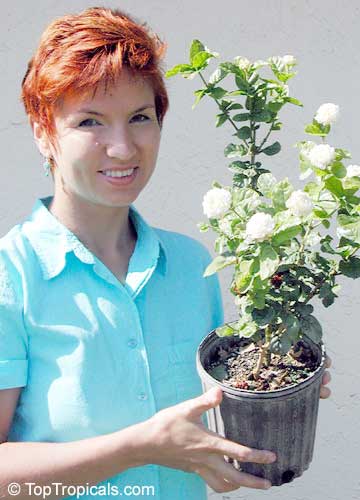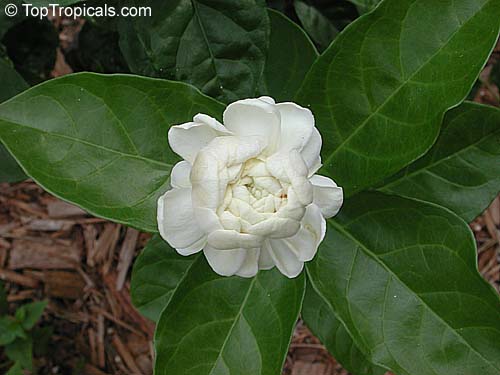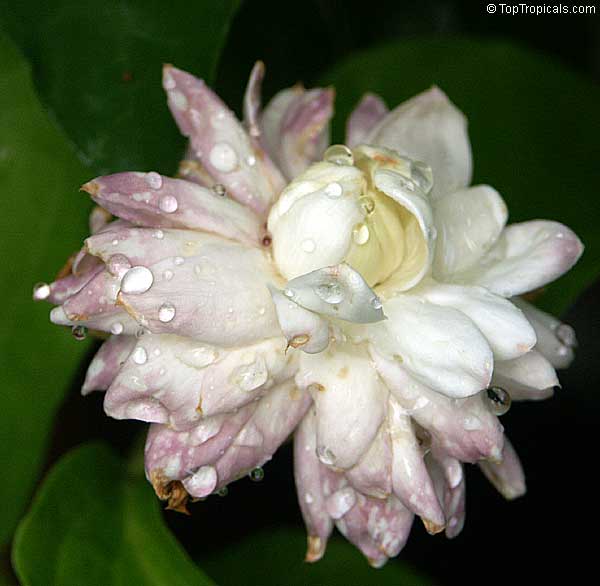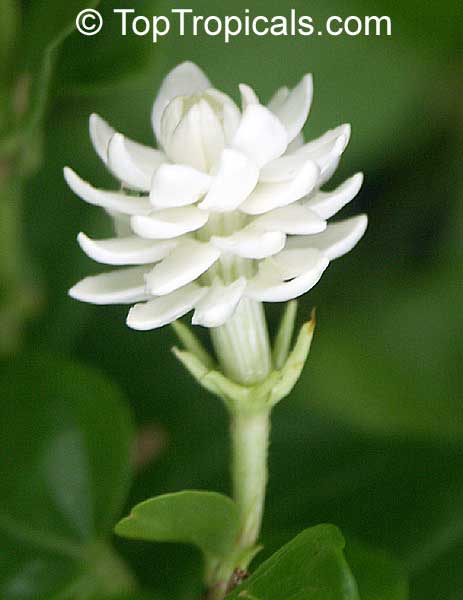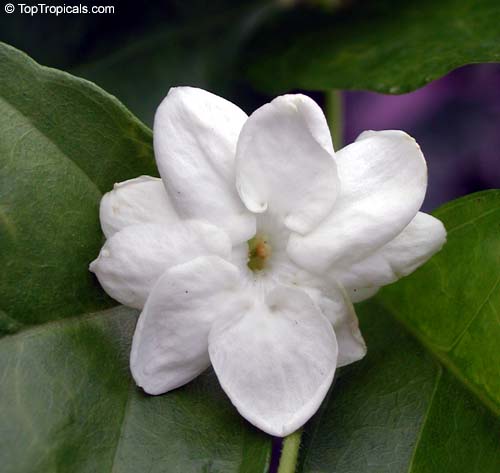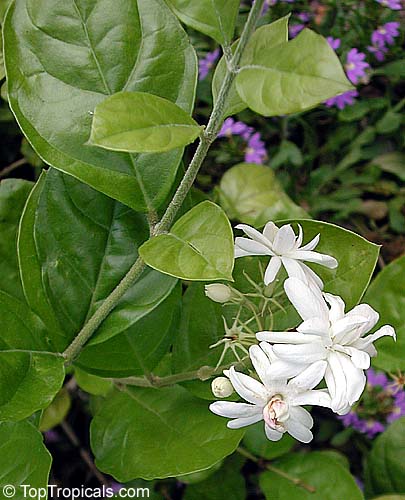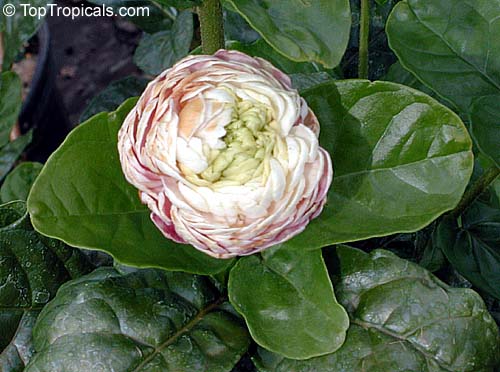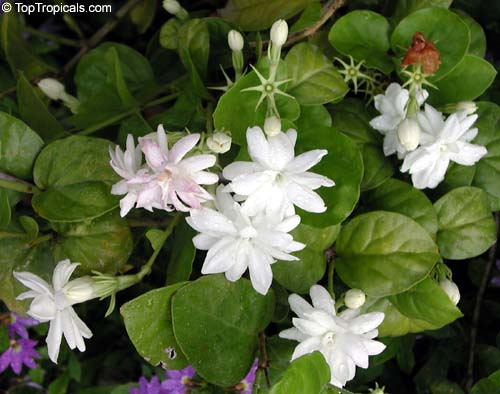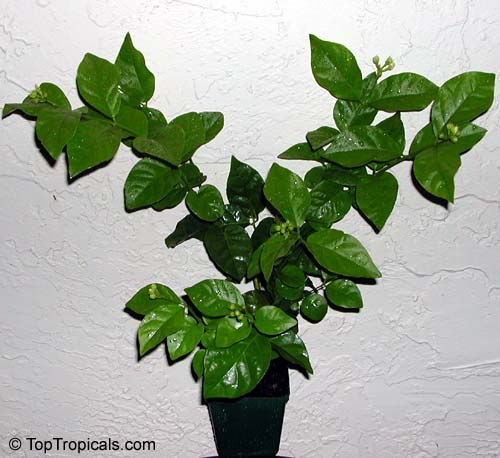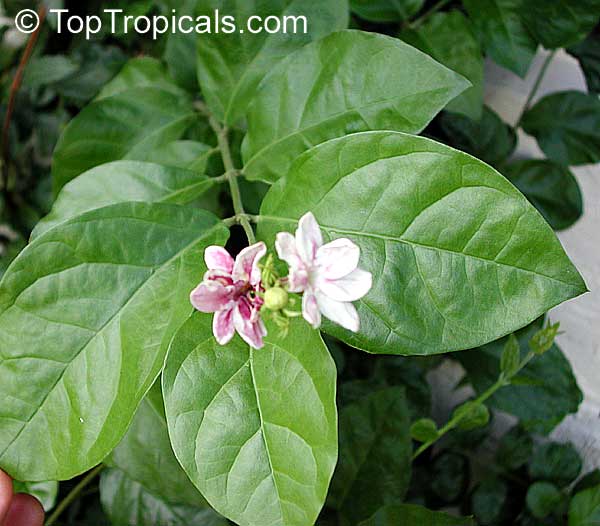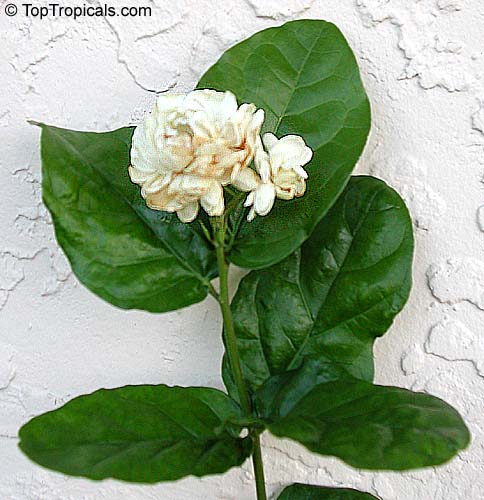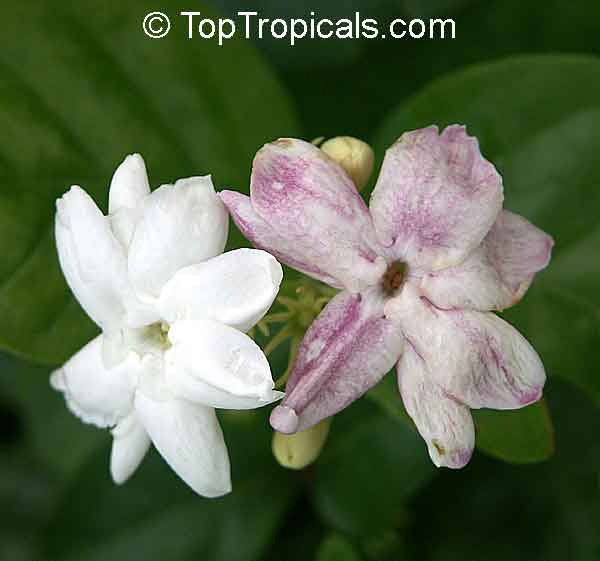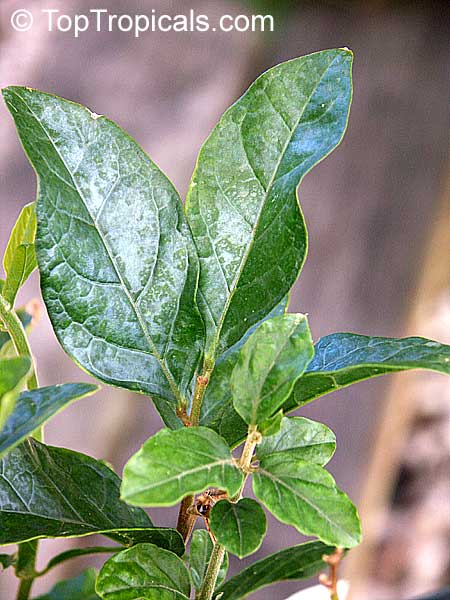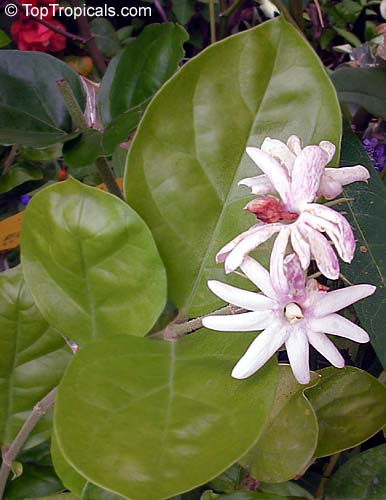Jasminum Sambac
Sambac varieties: Arabian Jasmine, Hawaiian Pikake...
click on image to enlarge
Everything about Sambac!
Buy this book

Keep a potted plant
in your bedroom
for night fragrance...
Perfect houseplant, takes both sun or shade,
Jasminum Sambac is a beautiful fragrant everbloomer both for your home
and garden.
Don't forget to collect the flowers for your morning jasmine
tea...
 VIDEO - Jasminum Sambac varieties
VIDEO - Jasminum Sambac varieties
Which variety to chose? - characteristics of different varieties
Growing Jasmines indoors - useful tips
Jasmine Facts - history info and fun stories about Sambacs
Confusing Varieties of Jasminum Sambac ("sport")
ORDER SAMBAC - buy this plant and see our special offers
"Jasminum Sambac - Absolute Flower" - TopTropicals Book about Jasmine Sambac and PDF file dowload.
Complete list of other Jasminum species
Family: Oleaceae. (Division: Magnoliophyta)
Origin: India, Iran, widely cultivated in South China.
Those wonderful memories of back home where growing fragrant flowers was something we took for granted... Even if one could not grow them, flowers could be purchased commercially and it was enough for decorations, poojas, gajaras, weddings and religious ceremonies. Even though the name Jasmine could be very confusing, its fragrance is what people want no matter what color the flowers have. Counting the variations amongst species, there are at least 20 to 30 different varieties of jasmine plants. Although common names may differ in different languages other than mentioned here, fragrance of these flowers remain common in our memory.
Jasminum sambac is an evergreen shrub, that often reaches 5 ft in height in pots. Called "pikake" in Hawaii, Jasminum Sambac is the plant used to flavor the jasmine tea and making perfumes.
Sambac blooms all year long in the greenhouse.
1 gal size plant
Jasminum Sambac Varieties
Grand Duke Supreme
Malichat (Mali-Chat)
"Grand Duke of Tuscany " ('Butt Mograw', 'Rose Jasmine') Origin: Iran. A slow growing Jasmine but grandest of them all, with the largest flowers. Up to 1.5" double flowers look like miniature roses. This tall growing shrub has Gardenia type flowers. The older plants seem to be more fascinating in providing flowers of different shapes and sizes on the same plant at the same time. A flower stays for a long time (few days) and doesn't drop off and in most cases will dry right on the plant. Same sweet fragrance of Maid of Orleans but stronger. This bushy compact plant needs a little more special attention than other Jasmines. Flower is used for tea and religious ceremonies. Requires frequent pruning for denser shape, otherwise becomes leggy. Everbloomer. Variety "Grand Duke Supreme" has yet bigger flowers and elongated leaves.
"Belle of India". (Madhan Mograw) Origin: India. Another beautiful and unusual species in the J. Sambac family. With it's long slender oval shape buds one cannot but admire the flowers when open. Sweet fragrance and double pure white 1" flower makes this jasmine a pleasure to grow. The flower is used in teas and religious ceremonies. This plant needs higher temperatures and light level to perform. Requires frequent pruning for denser shape. Intermediate shape between vine and shrub. Min. temp 60 F. Everbloomer.
"Maid Of Orleans" (Mograw', 'Motiya', 'Bela', 'Mallipoo', 'Lei pikake', 'Tea Jasmine', 'Gundi Mullige', 'Sampaguita') - . The most popular of all the jasmines in the world has round white extremely fragrant single flowers which are borne in profusion. It flowers from the tips, every 30-40 days, depending on the temperature.The hotter the better. The flowers drop off within 24 hours and are replaced with more the next day. This variety is used for making Hawaiian flower leis. It's picked as buds, and sown into high priced leis. Loves full drenching of water after the soil is little on the dry side. You will discover that the clarity and sweetness of fragrance of this jasmine is unrivaled. This bushy compact plant does particularly well on windowsills, but requres frequest pruning to kepp shape. The easiest variety to grow. In Asia, the flower is used in teas and religious ceremonies. More vining habit than other two, and foliage is the most beautiful and dark green. Min. temp. 60 F. Everbloomer.
"Mysore Mulli" is a ver close relative of Belle of India. It has slightly shorter patals than other Belle ('Elongata'). This variety is the most reliable bloomer of all sambacs. Although pale green, sometimes yellowish leaves are not the best part of the plant, the flowers are the most profuse and very strongly perfumed. It blooms practically year around, providing warm and bright light conditions.
"Arabian Nights" (Arabian Knights) is very close to Maid of Olreans, but the flowers are double, although not as large size as those of Grand Duke.
"Malichat" (Mali Chat) - is a rare hybrid, cultivated in Thailand. Flowers are multi-leveled (see picture), smaller size (1/2 inch), but very fragrant as all sambacs. In Thailand, this is the most popular variety for flower leis due to its flower shape, convenient for making garland.
Cultivation
To grow these plants outdoors, you have to be in zone 8 or higher. Jasmines like hot and humid conditions during the day, and cool temperatures at night. Since frost can kill these plants, with care one can successfully grow these as house plants.
Jasminum Sambac can be grown both in full sun (forms a nice bushy shrub when pruned) or in shade (tends to grow more like a vine, leaves get bigger and darker). Perfect container plant. Use great amount of organic matter when planting (leaf mold, peat moss, humus, compost), but soil must be well-drained and evenly moist at the same time. Jasmines do not like soggy conditions.
From spring through fall, fertilize monthly with a balanced fertilizer such as 10-10-10. Tie the stems to supports and keep the soil evenly moist through the growing season. Prune after flowering to keep the plants thinned and shaped. Some branches may reach 6 to 8 ft long. Pruning also helps keep an abundance of flowers, since flowers are produce on new wood.
Musore Mulli
Maid Of Orleans
Arabian Nights
Characteristics of different Sambac varieties: which one to chose?
speed
requirements
requirements
production
growing
Make a Jasmine tea.
Controllable, compact shape.
fast-growing
strong
fast-growing
Make a Jasmine tea. Blooms profusely in spring; the most beautiful leaves of all sambacs.
Arabian Nights vining shrub, branches may reach 4-5ftslow-
growing
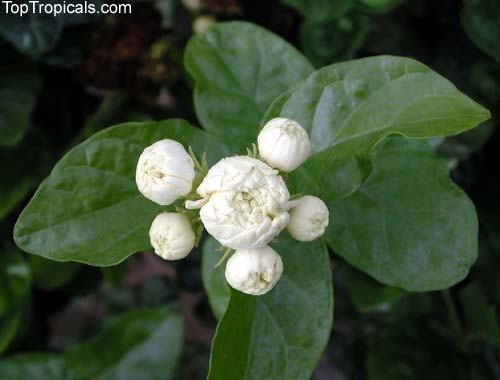
J.S. J.S. 'Grand Duke' buds
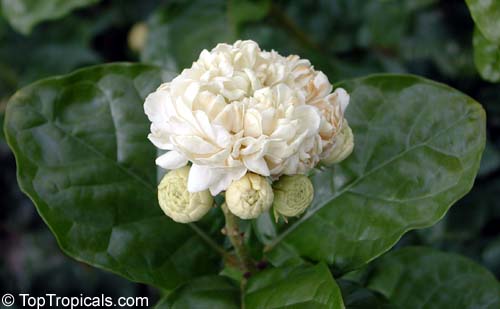
J.S. 'Grand Duke'

Faded flower of
J.S. 'Grand Duke'
stays on the plant
J.S. 'Grand Duke' bud sometimes has pinkish color
Mysore Mulli
10-12" plant
'Maid of Orleans'
Maid of Orleans" leaves are the most beautiful
Faded blossoms of Grand Duke stay on the stem and turn yellowish. The leaves a trefoil.
Pikake blossoms faded to palest violet are considered to be sacred to Vishnu
Elongated leaves of "Grad Duke Supreme"
Faded blossoms of both 'Belle of India' and 'Maid Of Orleans' drop off and turn pink. The leaves are bifoliate.
Growing Jasminum Sambac indoors
This plant is easy to grow in general. Many people from Northern States grow Sambacs successfully and enjoy the fragrance almost year 'round. The good thing for indoor culture is that Jasminum Sambac tolerates both shade and full sun and will bloom most of the year with a proper care. Of course the plant that was exposed to certain conditions for a long time gets used to them, and may get stressed after you change them significantly. For example, the plant that you kept in a shade, may get leaves burnt if you place it directly in full sun. The full-sun plant that was moved in a shade might drop some leaves. However, gradual change should be fine. Also keep in mind that the smaller the plant, the easier it gets adjusted to new conditions. On the other hand, if you are anxious about getting a developed blooming jasmine, it's probably a good idea to purchase a bigget size plant. Of course, in this case you should provide it with lots of light - as close as possible to how it was grown in our natural tropical conditions. If you cant't provide enough light and warm temperatures, the plant might stay in the same size for a very long period, and further flowering may be problematic.
Potting mix. Use only special potting soilless mix, with a large amount of organic matter, like peat moss. Potting mix must be well-drained (you may add perlite to improve drainage characteristics). Never use top soil or garden soil for potting - the roots will rot in it. More about potting soil...
Light. All plants need lots of light for blooming, and Sambac is not an exception. If you grow it indoors at all times, keep in in a well-lit spot by the window with southern exposure. During warm summer period when temperature is above 50F, it will be a good idea to take your plant outdoors to enjoy sun and fresh air on your balcony or patio. Bright light along with regular fertilization will encourage blooming.
Fertilizer. Be carefull not to over-fertilize - it might kill the plant. It's safe to use lower concentration of fertilizer more frequently, than rare application with a strong solution. Granulated slow-release fertilizer is better for pots than water-soluable. The cooler the temperature - the less fertilizer should be applied. (read more...).
Watering. Jasminum Sambac requires average watering. That means - do not water if the soil is moist. Maid of Orleans prefers to be more on a dry side. During winter months, reduce watering to once a week or even less frequent.
Humidity. Sambacs are tropical plants and they enjoy high humidity (50-80%). However, if growing them in a greenhouse, don't make it too wet for the plant, and make sure to provide a good air circulation at all times.
Re-potting. Move your plant into a new home (pot) every spring or when plant overgrows the pot. The new pot should be at least 2-3" wider than the old one. If the plant got root-bounded (too dense root ball at the bottom), make a few 1/2" deep cuts accross the sides of the rootball (4-5 cuts from top to bottom) to encourage new root growth, using a sharp knife. Add more fresh potting mix around the rootball and water well. Place the plant in filtered light for 2-3 days after re-potting.
Problems.
Leaves yellowing = over-watering or over-fertilizing
Leaves' green color pales = under-watering
Leaves dry on edges = under-watering
Buds drop before opening = over-watering
Buds open prematurely = over-watering
Flowers darken = too much heat
No flowers for the whole year = lack of light and/or fertilizer
No new growth for a long time = lack of light and/or fertilizer
Branches become leggy = prune regularly to keep bushy shape or let go to form
a vine, providing support
Leaves are too small = lack of food (fertilizer), too much sun
White mold on stems = indicates that you keep plant in dangerously moist conditions,
move it in a well-ventilated bright spot to dry.
A few notes about Jasminum Sambac and Maid of Orleans in particular (by Klodec, France)
I had once a Jasminum Sambac 'Maid of Orleans', and to my experience, it
is the less hardy of all Sambac cultivars.
I had a cutting, and bloomed readily after rooting, indoor of course ! But
to my guess, 'Maid of Orleans' needs a long period of regular heat, with a
small thermal amplitude between day an night and a good hygrometry.
Protect it from the winds, as they can cool down temperature very fast and
'hibernate' the plant, as colder temperatures are a great inhibitor to blooming.
- A key to induce blooming with the species Jasminum - and particularly
to Sambac is Long days, the longer day the better chance to bloom. So September,
in our lattitudes may be the ending of blooming season for this species.
- I would suggest to place it indoor, as you will have to anyway. Bear
in mind that a cold night can kill this plant, as it happened to me. 10°C,
and you can say goodbye to your baby Sambac...
- Try to give it supplemental light / heat / hygrometry
and it shall bloom.
- Sometimes, a temperature falloff, especially any brutal change can stress
the plant, and inhibit bud developpment, causing the bud to abort or look
awkward, and that could be the case with you.
- Remember that any plant from a serious nursery is given the best condition
from day to day, to make a beautiful plant with a lot of flowers, as long
as they want to sell healty and eye-catching plants. But when you bring
you brand new baby home, the conditions
- air - watering schedule - daytime/nightime temperatures - Light intensity, Light Duration - hygrometry - feeding schedule -
may be very different and can stress the plant, especially if the change is dramatic, and sudden. This stress can inhibit bud growth.
- Another guess if the plant is not blooming - 'Maid Of Orleans' might be
resting. It might have set up a lot of flowers before you bought it, and
then the plant is exhausted. Blooming is demanding a lot of energy, and
as said in a previous follow up, this rest may be part of a natural cycle
of this Marvelous plant. So be patient, another key to success !
- Talking about desease, in my experience, Sambac are subject to spider
mites attacks, specially indoor, and these pest can harm your plant, and
cause bud abortion. Sometimes a virus (?) - Maybe agrobacter tumefaciens
- can cause a kind of stem cancer. in this case, the stem, buds and leaves
can be ill formed, and I can't tell if there is a solution to this... it
happened to me though...
- Sambac cuttings are really easy to root, with or without IBA (hormone)
so you may want to take a few and try to give each differents conditions
of light/heat/hygrometry, and with this kind-of method of trial you might
find the best condition in your area for your Sambac, and get new clones
for free! Mathematically, the more plants, the more blooms at one given
time, the more fragrance in your room !
- Maybe you'll get to the point when you can make 'Lei', fragrant necklace,
a great gift to offer to your beloved... as they do in India, especially
on wedding days...
- Don't misspell ! This is "Maid of Orleans", NOT "Maid of New Orleans'. This is related to the french heroine 'Jeanne d'Arc' A.K.A. Maid of Orleans (Orleans, town from the North of France). The flower might have been given her name in symbolic reference to the white purity and the holly fragrance of the flower... Anyway I guess there are still some maids in New Orleans... So I won't bother if you insist...
Good luck - and happy gardening!
Are your plants really as big as on your pictures? I have ordered several plants from XXXXXX before which are smaller in size and do not have much fragrance. XXXXXX nurseries carries a special double petal jasmine sambac 'Mysore Molle'. I have ordered this plant twice from them but it did not survive because the plant they send is very small and not healthy.
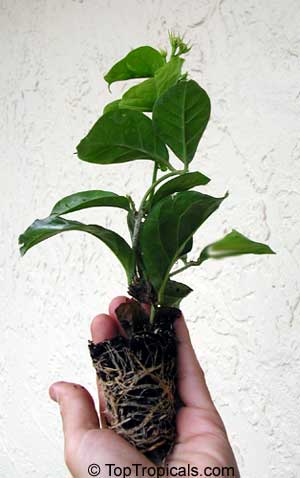
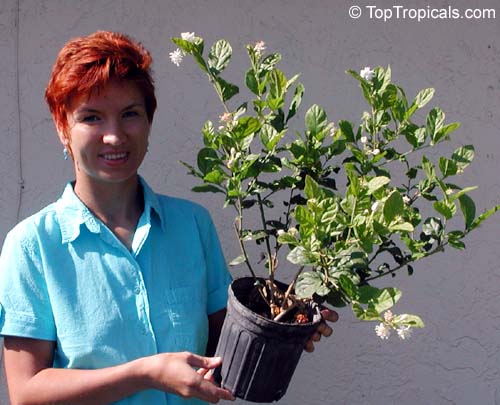
I'm ordering 10 of Jasminum Sambac 'Maid of Orleans' for my father's Birthday party. It's our national flower (Philippines). The party is in Queens, NY. Will the plants be safe to ship? Could you tell me if they will be in bloom?
We do ship Sambacs to NY, and they are OK. However, it's always recommended
to monitor the weather.
Make sure the plants have at least a few days indoors to adjust from shipping
stress before your party - for better bloom. In fact, 'Maid of Orleans' jasmines
are blooming all the time, it's just sometimes they have more flowers: they
keep blooming heavily for 3-4 days, then it looks like they take a "rest"
for a few days (less flowers), then again produce a "splash" of
flowers. So it' really hard to guess their "mood". However, the
big plants that we ship have both flowers and buds, so I hope they won't let
you down. Of course it's better to ship them beforehand, I would suggest 1-2
weeks before the party. Just make sure in NY they keep them on windowsills
- the more sun, the heavier the bloom. A sunny (southern) window exposure
will be perfect. Filtered light is OK too, as long as it's bright.
The flower of 'Maid of Orleans' is very tender and fragile and lasts only
a day or two, so for sure you'll lose most of opened flowers during the shipping.
So you will have to wait till next bloom "splash".
So the sooner you get them to the destination location - the better, as long
as the plants will have enough of SUNLIGHT to produce flowers before the party.
Which of your three Sambacs are the best, easiest to care for with most production?
'Maid of Orleans' is the easiest. Although it has single flowers, and the flower lasts just a day or two, but it blooms constantly, fragrance is wonderful. It's flowers are the best for jasmine tea (we make it all the time). Also, this variety tolerates shade the best (even deep shade!). Besides, it has more "climbing" habit (of course you may keep it srubby if you trim it). We have this plant covered the wall by our bedroom window (plant on the left):

'Grand Duke' has beautiful double flowers, but they are only on tips of a
branch. It needs more sun for more bloom, but also tolerates some shade.
'Belle of India' has long double petals, and it's also good for tea. Needs
more sun, too.
Does the Maid of Orleans need a trellis or will my courtyard wall alone do?
Maid of Orleans is the most fast growing Sambac, I like it myself the best, because it forms a very attractive shrub or vine. Flowers are not as fancy as other Sambacs, but also very fragrant, and they are what they make jasmine tea out of. It has the greenest and prettiest foliage, too. Maid of Orleans makes a vining shrub unless you prune it regularly (in that case it will be a nice dense shrub). The branches get as long as 10", but they are hard enough and don't need much support (unless they grow too long). We have it by the wall at our window (see picture above), and I just have attached couple branches to the wall - it was enough.
Can you give me information on growing Sambacs?
Should the Grand Duke be planted in a pot? I live in zone 9B.
All Sambacs are tropical plants and they might die if you have even a light frost in winter. So we recommend you just to plant them in 3 gal pots, that should be fine. Both full sun or shade is OK. Fertilize regularly, and make sure to use a good potting soil (with lots of organic matter like peat moss and humus).
What kind of soil do I need for potting Jasmine Sambacs and Cestrum Nocturnum?
Read about potting soil and fertilizers - here.
I noticed the buds of Belle of India plants to open early instead of maturing to bigger size buds before blooming. I was wondering why are they blooming into a flower pre-maturely? . When the plant arrived from your nursery it was full with big buds and they bloomed into fuller flowers with lot of fragrance. I am wondering where am I going wrong?
There could be a few reasons:
1) Do not over-fertilize. We apply slow-release fertilizer (granulated) -
3 months release. So we apply a table spoon every 3 months.
2) Do not over water. Sambacs prefer to be on dry side. Underwatering is better.
3) For bigger flowers, they need plenty of sun.
For more FAQ's - please visit our TopTropicals Plants FAQ Page.











